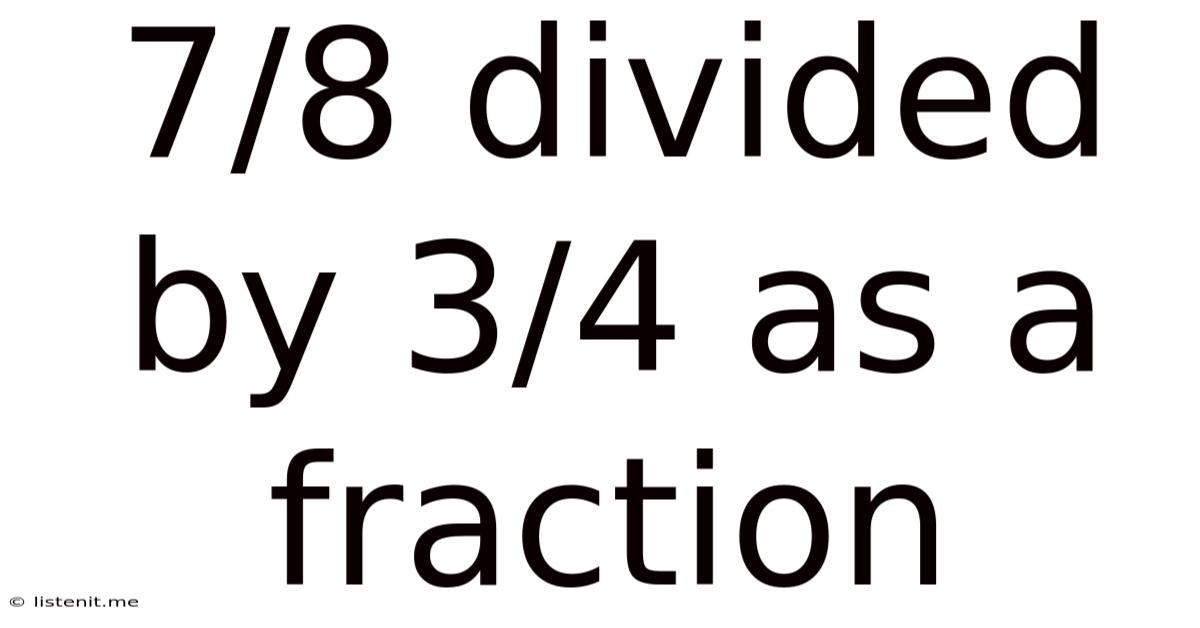7 8 Divided By 3 4 As A Fraction
listenit
May 10, 2025 · 4 min read

Table of Contents
7/8 Divided by 3/4 as a Fraction: A Comprehensive Guide
Dividing fractions can seem daunting at first, but with a clear understanding of the process, it becomes straightforward. This article will delve into the intricacies of dividing 7/8 by 3/4, explaining the steps involved, providing alternative methods, and exploring the broader concept of fraction division. We'll also touch upon real-world applications and practical tips to master this fundamental mathematical operation.
Understanding Fraction Division
Before tackling the specific problem of 7/8 ÷ 3/4, let's establish a solid foundation in fraction division. The core principle revolves around the concept of reciprocals (also known as multiplicative inverses). The reciprocal of a fraction is obtained by simply switching the numerator and the denominator. For example, the reciprocal of 3/4 is 4/3.
The key rule for dividing fractions is: To divide a fraction by another fraction, multiply the first fraction by the reciprocal of the second fraction. This means we transform the division problem into a multiplication problem, which is generally easier to manage.
Solving 7/8 Divided by 3/4
Now, let's apply this rule to our problem: 7/8 ÷ 3/4.
-
Find the reciprocal of the second fraction: The reciprocal of 3/4 is 4/3.
-
Rewrite the division as multiplication: Our problem now becomes: 7/8 × 4/3.
-
Multiply the numerators: 7 × 4 = 28
-
Multiply the denominators: 8 × 3 = 24
-
Simplify the resulting fraction: We now have the fraction 28/24. Both the numerator and denominator are divisible by 4. Dividing both by 4, we get 7/6.
-
Convert to a mixed number (optional): The improper fraction 7/6 can be converted to a mixed number. Since 7 divided by 6 is 1 with a remainder of 1, the mixed number equivalent is 1 1/6.
Therefore, 7/8 ÷ 3/4 = 7/6 or 1 1/6.
Alternative Methods and Visual Representations
While the reciprocal method is the most common and efficient approach, there are other ways to visualize and solve this problem.
Method 1: Using a common denominator
This method involves finding a common denominator for both fractions and then dividing the numerators. While it's less efficient for this specific problem, it's a valuable technique for understanding the underlying principles.
-
Find a common denominator: A common denominator for 8 and 4 is 8.
-
Rewrite the fractions with the common denominator: 7/8 remains the same, and 3/4 becomes 6/8.
-
Divide the numerators: 7 ÷ 6 = 7/6
This method yields the same result: 7/6 or 1 1/6.
Method 2: Visual Representation with Area Models
Imagine a rectangle representing the whole (1). Divide it into 8 equal parts to represent 7/8. Then, think about dividing these 7/8 into groups of 3/4. Visually partitioning the rectangle helps understand the division process, though it becomes less practical for more complex fractions.
Real-World Applications
Understanding fraction division is crucial in various real-world scenarios:
-
Cooking and Baking: Scaling recipes up or down requires dividing and multiplying fractions. If a recipe calls for 3/4 cup of flour and you want to make half the recipe, you need to divide 3/4 by 2 (or multiply by 1/2).
-
Sewing and Crafting: Calculating fabric lengths or yarn quantities often involves fraction division.
-
Construction and Engineering: Precise measurements and calculations in construction and engineering frequently involve fractions and their manipulation.
-
Financial Calculations: Dividing profits or splitting costs often necessitate fractional arithmetic.
Mastering Fraction Division: Tips and Tricks
-
Practice Regularly: Consistent practice is key to mastering any mathematical skill. Work through various problems, starting with simpler ones and gradually increasing the complexity.
-
Understand the Concepts: Don't just memorize the steps; understand why the reciprocal method works. This deep understanding will help you solve more complex problems.
-
Use Visual Aids: For beginners, visual aids like diagrams and area models can make the process more intuitive.
-
Check Your Work: Always double-check your answers. You can do this by converting improper fractions to mixed numbers or by using an online calculator to verify your calculations.
Expanding Your Knowledge: Further Exploration
Understanding fraction division is a stepping stone to more advanced mathematical concepts. From there, you can explore:
-
Dividing mixed numbers: This involves converting mixed numbers to improper fractions before applying the reciprocal method.
-
Dividing decimals: This involves converting decimals to fractions before applying the reciprocal method or using decimal division directly.
-
Complex fractions: These involve fractions within fractions, requiring a multi-step approach to simplification.
-
Algebraic fractions: This involves applying the principles of fraction division to algebraic expressions.
By mastering fraction division, you build a solid foundation for more advanced mathematical concepts and practical applications in various fields. Remember, practice and a thorough understanding of the underlying principles are crucial for success. Through consistent effort and the strategies outlined above, you can confidently tackle any fraction division problem.
Latest Posts
Latest Posts
-
A Solution With A Ph Of 8 Is
May 10, 2025
-
Do Metals More Readily Gain Or Lose Electrons
May 10, 2025
-
Evaluate The Integral 9 X2 81 Dx 0
May 10, 2025
-
Orange Juice With Pulp Homogeneous Or Heterogeneous
May 10, 2025
-
How To Put Log Base In Ti 83 Plus
May 10, 2025
Related Post
Thank you for visiting our website which covers about 7 8 Divided By 3 4 As A Fraction . We hope the information provided has been useful to you. Feel free to contact us if you have any questions or need further assistance. See you next time and don't miss to bookmark.